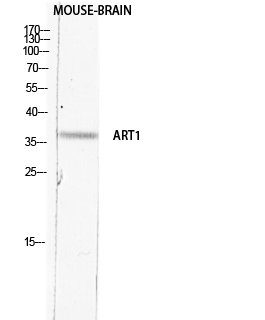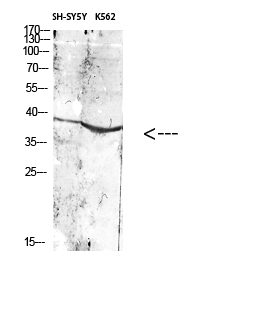产品名称
CD296 Rabbit Polyclonal Antibody
别名
ART1; GPI-linked NAD(P)(+)--arginine ADP-ribosyltransferase 1; ADP-ribosyltransferase C2 and C3 toxin-like 1; ARTC1; Mono(ADP-ribosyl)transferase 1; CD296
蛋白名称
GPI-linked NAD(P)(+)--arginine ADP-ribosyltransferase 1
存储缓冲液
Liquid in PBS containing 50% glycerol, 0.5% BSA and 0.02% New type preservative N.
Human Gene Link
http://www.ncbi.nlm.nih.gov/sites/entrez?db=gene&term=417
Human Swissprot No.
P52961
Human Swissprot Link
http://www.uniprot.org/uniprotkb/P52961/entry
Mouse Gene Link
http://www.ncbi.nlm.nih.gov/sites/entrez?db=gene&term=11870
Mouse Swissprot No.
Q60935
Mouse Swissprot Link
http://www.uniprot.org/uniprot/Q60935
Rat Gene Link
http://www.ncbi.nlm.nih.gov/sites/entrez?db=gene&term=
Rat Swissprot Link
http://www.uniprot.org/uniprot/
免疫原
The antiserum was produced against synthesized peptide derived from the Internal region of human ART1. AA range:51-100
特异性
CD296 Polyclonal Antibody detects endogenous levels of CD296 protein.
稀释度
WB 1:500 - 1:2000. ELISA: 1:10000. Not yet tested in other applications.
宿主
Polyclonal, Rabbit,IgG
背景介绍
ADP-ribosyltransferase catalyzes the ADP-ribosylation of arginine residues in proteins. Mono-ADP-ribosylation is a posttranslational modification of proteins that is interfered with by a variety of bacterial toxins including cholera, pertussis, and heat-labile enterotoxins of E. coli. The amino acid sequence consists of predominantly hydrophobic N- and C-terminal regions, which is characteristic of glycosylphosphatidylinositol (GPI)-anchored proteins. This gene was previously designated ART2. [provided by RefSeq, Jul 2008],
细胞定位
Sarcoplasmic reticulum membrane; Lipid-anchor, GPI-anchor.
功能
catalytic activity:NAD(+) + protein-L-arginine = nicotinamide + N(omega)-(ADP-D-ribosyl)-protein-L-arginine.,catalytic activity:NADP(+) + protein-L-arginine = nicotinamide + N(omega)-((2'-phospho-ADP)-D-ribosyl)-protein-L-arginine.,similarity:Belongs to the Arg-specific ADP-ribosyltransferase family.,
纯化
The antibody was affinity-purified from rabbit antiserum by affinity-chromatography using epitope-specific immunogen.


